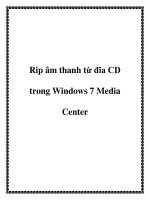Watch The Web: Media Center Guide
Bạn đang xem bản rút gọn của tài liệu. Xem và tải ngay bản đầy đủ của tài liệu tại đây (2.89 MB, 69 trang )
Watch The Web:
Media Center Guide
2011
By: Matt Smith,
Edited by Justin Pot
This manual is the intellectual property of
MakeUseOf. It must only be published in its
original form. Using parts or republishing altered
parts of this guide is prohibited without permission
from MakeUseOf.com
Think you’ve got what it takes to write a manual
for MakeUseOf.com? We’re always willing to
hear a pitch! Send your ideas to
; you might earn up to
$400.
Table of Contents
Introduction
Making the Transition
Choosing an Off-The-Shelf Media Center
Building a BIY Media Center/HTPC
Troubleshooting Common Problems
Conclusion
MakeUseOf
Introduction
Welcome to Internet Television
Television has been around for decades. Once
upon a time, it was revolutionary. Today, it’s
considered by many to be a necessity rather than a
luxury. That makes it easy to assume there’s little
more to be said about the story of television, but
that’s simply not the case. Like many mature,
commonly adopted technologies, television is
evolving to take advantage of new technology, and
this means changes in how it can be used.
For most of its life, television has been associated
strictly with the hardware itself. A cable brought
shows to your television and only your television,
so there wasn’t much choice in terms of how you
could consume what you received. Eventually
video recorders made it possible to tape shows
and watch them later, but it’s only within the last
decade that it’s been possible for consumers to
disassociate television from the hardware entirely.
Today, television is a service. There is certainly
an argument to be made about whether the word
television is no longer particularly useful as a
means of describing how many people now
consume shows and movies, but that’s beyond the
scope of this guide.
Whatever terms you’d like to use, there’s no
denying that much of what was once accessible
only through your television service on your
television can now be accessed through multiple
services on multiple devices.
This means that you can cut the cord with your
traditional cable or satellite service – but before
you do, you should know what you’re getting into.
Internet television exists, but to call it mature
would be disingenuous. You should know what to
expect before making the leap – and I’ll help you
prepare.
You Don’t Have to Pay. Much.
The first argument most proponents of Internet
television will make is about cost. With cable
services typically running between $40 and $100 a
month (on top of what you pay for Internet) it’s
easy to see why. Quality cable or satellite service
isn’t cheap. Internet television isn’t always free
either, however. Sure, you don’t have to pay
anything extra on your Internet bill to access
television online, but that doesn’t mean you’ll be
able to obtain all the content that you want without
incurring costs.
Even a Netflix subscription costs money, but for
many users, the costs may not end here. You’ll also
have to consider the potential cost of the new or
upgraded hardware required to make watching
content online a pleasurable experience. It’s also
likely that, for hardcore boob-tube junkies, a
subscription to any single service won’t be enough.
Lump in a few digital movie rentals and suddenly
the cost of online television is on par with basic
cable.
However, that’s not an entirely fair comparison.
You may have ended up paying for some of that
content anyway, simply because you wanted to
watch it on a PC, or it wasn’t available from your
service. In addition to this, you’ll have more
choice over your bill. It’s becoming unfortunately
common for cable and satellite services to place
their customers into contracts. Netflix, on the other
hand, isn’t asking for a two- year commitment.
Still, the point is that getting your TV fix online
isn’t always free. There may be some costs, but
you can mitigate them if you know how.
Hardware and Software – A Match
Made In Thailand, or Singapore, or
Korea
Often, when preparing to make the switch to
Internet television, it’s easy to focus on just the
hardware or software part of the transition.
Sometimes big names like Netflix flash on radar
screens, while other buyers might be focusing their
efforts on the choice between a Roku and a Boxee
Box.
Focusing on one or the other is easy, but also not
particularly useful. Users looking for the full
Internet television experience – one that does not
make sacrifices in terms of quality or selection –
will need to consider both when making the
switch. Inadequate hardware can make the
experience poor because of choppy performance
when watching HD content or other issues, such as
a lack of quality audio support. Poor software, on
the other hand, can reduce both quality and
selection. Attempting to live simply off YouTube
and the free TV episodes posted online by major
networks is only feasible for casual viewers.
In this guide I will touch on both the hardware and
software aspects of the conversion. But before we
delve into making purchases, let’s take a thorough
look at what the transition from a traditional cable
or satellite service to Internet television means to
you.
Making the Transition
Cutting the Cable Cord
There’s a lot to consider when making the
transition from a cable or satellite service to
Internet TV, and one of the most important
considerations is the content you’ll have access to.
Before severing from your traditional provider you
need to think about how you’ll gain access to the
entertainment you enjoy the most. There are no
more channels – just a vast online ocean of content
that often must be trawled through to find the best.
The Free Content Menu
Free! Access to free content is probably what
garnered your attention in the first place, so let’s
talk about free shows first.
There’s a great deal of free entertainment available
online, much of which is provided by the
producers of the shows themselves. ABC, CBS,
Fox and NBC all provide access to recently
broadcasted shows, and many premium cable
channels like Comedy Central and SyFy also have
a significant online presence. Using players in a
web browser, you can watch shows for free,
although you’ll still have to deal with the
occasional commercial interruption.
Not that this list applies mostly to America. Those
living in other countries will experience varying
degrees of access to content, so do your
homework. Obviously, the upside is the price. You
don’t have to pay anything extra to access these
shows, so you can watch until your heart’s content
without adding additional charges to your bank
account. You may not even need to sacrifice
quality, because many sites offer HD versions of
their shows that in some cases – if you have
sufficient bandwidth – have better picture quality
than what you would receive from a cable or
satellite service.
On the other hand, “many” is not “all.” There are
some sites that don’t offer great picture quality for
the shows they have online. Selection can also be a
problem, because the episodes available rarely
stay online forever. They’re usually offered only
for a limited time, and you’ll often have to wait a
week after the original air date of an episode to
watch it. That will be a bummer for people who
like to keep up to date with their favorite shows.
Of course, I’ve so far only touched on the legal
ways to obtain free content. If you’re willing to go
beyond legal access, you’ll be able to obtain all
sorts of content. Although the efforts of copyright
owners across the globe to stomp out free sharing
of movies and shows have had some impact,
there’s still a huge variety of sites that make it easy
for people to share whatever they have on their
hard drives.
If you’re not already, you’ll want to become
familiar with the concept of a torrent. This is a
peer-to-peer file sharing system in which everyone
who’s part of the torrent can both download and
share the content in question – so after (or while)
you’re downloading a movie, the torrent program
will use your computer to share it with others as
well. This decentralized method of sharing has
become popular because it’s hard for authorities to
stop. There’s no central server to go after – just a
diffuse network of users.
You should recognize that there is some risk with
obtaining content illegally. Although the efforts of
copyright holders to stop file sharing have had
limited success, people have been successfully
sued for this, and will be successfully sued in the
future. Although unlikely, the possibility of being
caught is a reality.
Paid Content Options
Although there’s a lot of free content online, it’s
probably not enough to satisfy the most avid fans of
television. If you’d like access to high-quality,
current content without running the risk of being
visited by corporate lawyers you’re going to have
to lay down some cash. Fortunately, it doesn’t have
to be much.
There are numerous services available, but they
tend to fall into two broad categories. Those are
subscription services and on-demand services.
Netflix is the dominant service in this area, but it’s
been joined recently by Hulu Plus, and there will
certainly be others to come. With a subscription
service you pay a fee every month and in exchange
you receive unlimited access to the content
provided. Of the two major players in this game
right now – Netflix and Hulu Plus – the former
tends to focus on movies and a wide variety of
shows while Hulu Plus tries to focus on recent
television content.
The advantage of these services is the amount of
content you can access for the price. In the United
States, Netflix is $7.99 per month for an online-
only subscription; Hulu Plus is also priced at
$7.99. For that, you receive access to Internet
television on a wide variety of devices with no
limit on the amount that you can watch. It’s just like
a cable or satellite service, only cheaper – you
fork over the dough, and then you don’t have to
worry about paying for anything for the rest of the
month. However, although both Netflix and Hulu
Plus contain a huge library of content, it’s not
unlimited. You’re only going to have access to
certain shows, and obviously if they don’t provide
what you’re looking for, you’re going to have go
elsewhere. That’s no different from cable or
satellite, but at least with those services you know
you’ll receive everything on a channel, and that’s
not always true for online content.
That’s where the on-demand services come in.
There are a lot of these available including
Amazon.com, iTunes, Xbox Live, and sometimes
the websites of the content producers themselves.
The idea of on-demand content is simple – you buy
or rent only what you actually want to watch when
you want to watch it.
This could work out to be cost effective if the
pricing was low, but often it’s not. HD movie
rentals on Xbox Live, for example, are usually $4
to $6 USD (Microsoft actually prices them in its
“Microsoft Points” currency). This makes on-
demand content difficult to justify as your sole
means of access to shows and movies, but it’s a
good supplement for a subscription service.
The Disadvantage of Internet
Television
Making the switch to Internet television isn’t all
roses and butterflies. While you can save a lot of
money, there are some pitfalls that you’ll need to
be aware of before you take the plunge.
The first thing you’ll need to be aware of is the
simple fact that the shows you want to watch may
not always be available in the best format, or in the
most timely manner. As stated earlier, most
network sites offer shows a week after the original
was aired, but it’s entirely up to them when they
want to put the show online and when they want to
take it back down. If you love watching shows as
soon as they air or you find missing an episode
frustrating, online sources may cause you some
heartache.
Sports are another problem. While there are some
services that offer streaming of live events, they’re
few and far between and frequently illegal.
Another problem you might encounter is the
bandwidth your Internet connection makes
available. There are literally billions of people
around the world that don’t have access to
broadband or only have access to a connection
with a speed of 5 Mbps. Although this should be
obvious, I’ll say it anyway – if you don’t have
broadband, forget about this plan now. If you have
broadband but have limited speed, you can still
enjoy Internet television, but you’re going to have
to deal with image quality that may not be as good
as what you’ve come to enjoy from cable or
satellite.
Speaking of bandwidth, there’s another potential
problem related to Internet service – data caps. It’s
becoming increasingly common for Internet service
providers to impose some sort of data cap on their
services. Usually it’s a very high cap, somewhere
in the neighborhood of 150 to 250 gigabytes or
more, but it is possible to blow through a cap that
high if you’re addicted to watching or
downloading high-definition content without much
compression. This can result in additional fees
from your ISP or temporary termination of service.
Although this scenario isn’t terribly likely, it is
possible and should be kept in mind.
Choosing an Off-The- Shelf
Media Center
Why Buy a Media Center
When Internet television first became available –
largely through illegal downloads of shows and
movies – there weren’t many options for viewing
it. Most of the content was available only as video
files that could be played back on PCs. This, along
with the video capture cards that recorded the
content in the first place, resulted in the birth of the
home theater PC.
Today the market is different. While HTPCs still
exist – and we’ll talk about building or buying one
in the next chapter – there is also a wide variety of
off-the-shelf media centers available. Internet
television is still a small market compared to the
more traditional cable and satellite services, but
it’s growing, and companies are lining up to take
advantage of that growth. Let’s take a look at
what’s currently available.
Apple TV
Apple’s media center is a small, rounded box that
looks a lot like a Mac Mini. Unlike many of the
options on this list, the Mac Mini is powered by an
ARM A4 processor – the same in Apple’s iPhone
4. This makes the Apple TV a small, power
efficient and quiet device, but it also puts it at a
hardware disadvantage. Unlike many competitors,
the Apple TV only supports 720p video playback
at up to 30 frames per second.
As one might expect, integration with the iTunes
store is central to the Apple TV experience. This
makes the device excellent for users who like
access to on-demand content or buy a lot of digital









